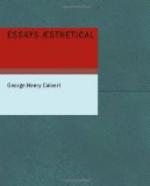A poem, a genuine poem, assumes its form by an inward necessity. “Paradise Lost,” conceived in Milton’s brain, could not utter itself in any other mode than the unrhymed harmonies that have given to our language a new music. It could not have been written in the Spenserian stanza. What would the “Fairy Queen” be in blank verse? For his theme and mood Dante felt the need of the delicate bond of rhyme, which enlivens musical cadence with sweet reiteration. Rhyme was then a new element in verse, a modern aesthetic creation; and it is a help and an added beauty, if it be not obtrusive and too self-conscious, and if it be not a target at which the line aims; for then it becomes a clog to freedom of movement, and the pivot of factitious pauses, that are offensive both to sense and to ear. Like buds that lie half-hidden in leaves, rhymes should peep out, sparkling but modest, from the cover of words, falling on the ear as though they were the irrepressible strokes of a melodious pulse at the heart of the verse.
The terza rima—already in use—Dante adopted as suitable to continuous narrative. With his feeling and aesthetic want rhymed verse harmonized, the triple repetition offering no obstacle, Italian being copious in endings of like sound. His measure is iambic, free iambic, and every line consists, not of ten syllables, but of eleven, his native tongue having none other than feminine rhymes. And this weakness is so inherent in Italian speech, that every line even of the blank verse in all the twenty-two tragedies of Alfieri ends femininely, that is, with an unaccented eleventh syllable. In all Italian rhyme there is thus always a double rhyme, the final syllable, moreover, invariably ending with a vowel. This, besides being too much rhyme and too much vowel, is, in iambic lines, metrically a defect, the eleventh syllable being a superfluous syllable.
In these two prominent features English verse is different from Italian: it has feminine rhymes, but the larger part of its rhymes are masculine; and it has fewer than Italian. This second characteristic, the comparative fewness of rhymes, is likewise one of its sources of strength: it denotes musical richness and not poverty, as at first aspect it seems to do, the paucity of like-sounding syllables implying variety in its sounds. It has all the vocalic syllables and endings it needs for softness, and incloses them mostly in consonants for condensation, vigor, and emphasis.
Primarily the translator has to consider the resources and individualities of his own tongue. In the case of Dante the rhythmical basis is the same in both languages; for the iambic measure is our chief poetic vehicle, wrought to perfection by Shakespeare and Milton. There only remains, then, rhyme and the division into stanzas. Can the terza rima, as used by Dante, be called a stanza? The lines are not separated into trios, but run into one another, clinging very properly to the rhymes, which, interlinking




